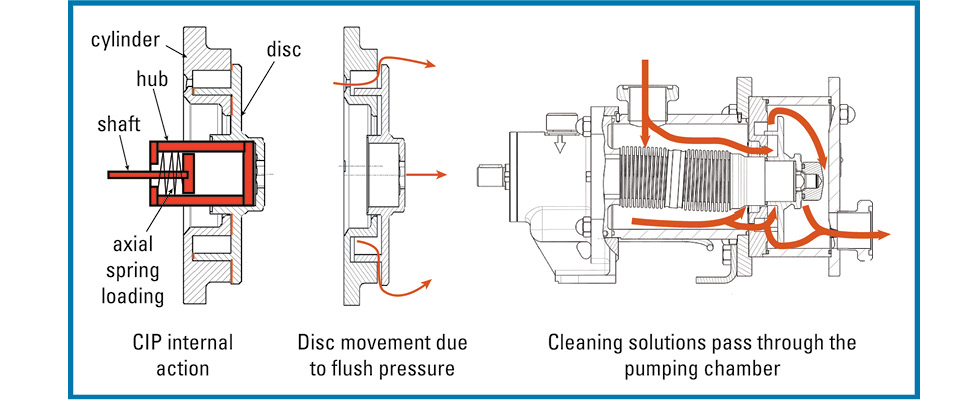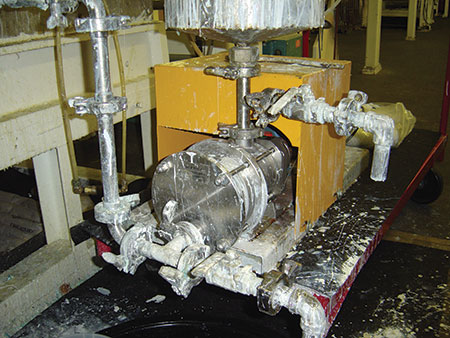
The Challenge
A paint and coatings plant that produces both cationic paste with pigments and cationic binders without pigments for truck shipment to automotive OEMs experienced difficulties when transferring the compounds from mobile tanks to trucks.
In particular, the types of pumps that were being used were incapable of totally draining the pipes, hoses and mobile tanks used in the process, leading to wasted time and materials, as well as an increase in the probability of leakage occurring.
The trucks are loaded with cationic binders from mobile tanks, meaning frequent human involvement, so the plant operators were looking to upgrade to a style of pump that would make the overall operation cleaner and more efficient.
Because of the specific types of binders that are handled, as well as the operators’ requirements for clean, time-sensitive performance, a versatile pump needed to be incorporated—one that is sealless, provides low shear, clean-in-place (CIP) capabilities and high volumetric efficiencies.
The Solution
The plant selected a new pump that featured eccentric disc technology. Four years after installation, the pump continues to optimally operate. The key to its operation is the pump’s ability to drain the inlet hose, mobile tank and outlet pipe completely at the end of the loading process. Additionally, this pump does not have a mechanical seal, so product leakage does not occur.
A sealless eccentric disc pump proved ideal for this application because of these important design benefits:
- Sealless design in which there are no mechanical seals, magnets, rubber or polytetrafluoroethylene (PTFE) diaphragms
- Low-shear handling of products with low slip, lower internal velocities and ultra-low agitation
- CIP capability that allows the pump to be completely drained, flushed and cleaned without disassembly
- High volumetric efficiency that is able to maintain a constant flow rate at a given viscosity throughout its pressure range
- Good compression performance and the ability to run dry (up to 10 seconds) enabling excellent self-priming capabilities and complete line stripping of suction and discharge lines
- Self-adjusting operation that maintains delivery/pressure performance over time through the use of a self-adjusting disc/cylinder
Because of the last characteristic, eccentric disc pumps can also be used as dosing pumps (Image 1). Since the pump is automatically self-adjusting, it maintains great efficiency and repeatability over time.

The Technology
Eccentric disc pumps consist of a cylinder and pumping element mounted on an eccentric shaft. As the eccentric shaft is rotated, the pumping element forms chambers within the cylinder, which increase in size at the intake port, drawing fluid into the pumping chamber. The fluid is transported to the discharge port where the pumping chamber size is decreased. This action squeezes the fluid out into the discharge piping.
Operating Principle
Eccentric disc pumps typically have a shear rate of sec-1 = 0.9 rotations per minute (rpm), which is lower than other types of pumps used in paint and coatings applications. This is due in part to the gentle, low-velocity action of the disc and cylinder and the extremely low slip rate of the pump.
Eccentric disc pumps do not have required clearances that can cause slip, which is the portion of the pumped product that is forced back to the suction side of the pump due to pressure through the clearances.
In these pumps, the discharge pressure exerts itself against the eccentric disc in a way that assists in maintaining axial contact with the cylinder, thus mitigating the usual effect that discharge pressure has on slip in pumps. It is this low slip between the disc and cylinder that gives the pump the ability to self-prime and line strip.
Eccentric disc pumps are typically capable of handling viscosities of up to 10,000 centipoise (Cp), working pressures up to 130 pounds per square inch (psi) (9 bar), capacities of 4 to 158 gallons per minute, operating temperatures up to 176 F and a particle-size range of 1 to 3 millimeters.
Regarding CIP technology, some eccentric disc pumps hold 3A Approval Certification and are designed per European Hygienic Equipment Design Group (EHEDG) specifications to be flushed and cleaned in place.

When installed for CIP operation, eccentric disc pumps experience no loss of performance due to vertical drain porting. When cleaning, pressure is introduced to the back of the eccentric disc through the pump chamber (Image 2). When the flush pressure overcomes the spring, the disc moves away from the cylinder, allowing the cleaning solution to pass through the pumping chamber. This feature allows a relatively large volume of cleaning fluid to sweep through the pump, providing a thorough cleaning and often eliminating the need for bypass piping for the CIP mode.
Regarding maintenance, eccentric disc pumps consist of few parts. The cylinder-disc assembly can be replaced without disturbing the suction piping or drive components.
Eccentric Disc Technology vs. Others
Because of these characteristics, eccentric disc pumps are able to supply important benefits that pumps traditionally utilized in the paint and coatings market sector may not be able to provide.
- Air-operated diaphragm (AOD) pumps: AODs have traditionally been the pump of choice in the paint and coatings market because of their low initial purchase cost. However, some types of AOD pumps are inefficient and require high maintenance, increasing their total cost of ownership.
- Gear pumps: These are the second-most popular pump choice behind AODs due to their capability of handling higher viscosity ranges. The weaknesses of gear pumps include excessive seal leakage, inability to self-prime, a flow rate that is jeopardized when wear begins and high internal velocities that affect fluid dynamics. This leads to shear and clearances that result in slip as pressures increase and viscosities decrease.
- Centrifugal pumps: The primary drawback of centrifugal pumps is their high rate of slippage. Centrifugal pumps typically have lower efficiencies than eccentric disc pumps.
- Lobe pumps: Lobe-type pumps perform like gear pumps, meaning they have many of the same drawbacks that gear pumps have. Also, the need to seal two shafts doubles the expense of seals and the potential for leakage.
A final benefit of the eccentric disc pump is its ability to be used in many applications. In the paint and coatings industry, that could include the pumping of pigments, resins, solvents and additives. These capabilities help make eccentric-disc technology a great solution to addressing pump seal, suction, product shear and volumetric efficiency concerns.
Through the incorporation of such benefits as leak-free operation and line-stripping capabilities, the eccentric-disc principle makes the pump extremely flexible, allowing the pumping of low-viscosity, high-viscosity and highly abrasive materials within a single process, all with the same pump. This makes the eccentric disc pump not only a longer-lasting, more efficient piece of equipment, but a multitasking one as well—and possibly the answer for many difficult pumping applications in the paint and coatings industry.


